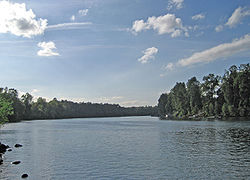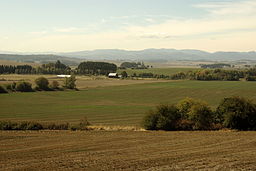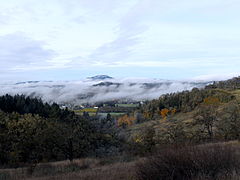- Willamette Valley
-
This article is about the geographic feature. For other uses, see Willamette Valley (disambiguation).
Willamette Valley Valley Farmscape in northern Polk CountyCountry United States State Oregon Borders on Cascade Range (East)
Oregon Coast Range (West)
Calapooya Mountains (South)Side valleys - left Yamhill Valley
Tualatin ValleyRiver Willamette River Geology alluvial plain Orogeny Catastrophic Ice Age Flooding Period several The Willamette Valley (
 /wɨˈlæmɨt/ wil-lam-it) is the most populated region in the state of Oregon of the United States. Located in the state's northwest, the region is surrounded by tall mountain ranges to the east, west and south and the valley's floor is broad, flat and fertile because of Ice Age conditions. Located centrally inside the large alluvial-deposited soils of the Willamette River drainage basin, the valley spreads far from the river banks to both the east and west barrier ranges as the river proceeds northward from its emergence from the Calapooya Mountains near Eugene to the confluence of the Willamette with the Columbia River at Portland. The valley's waterways and tributary streams and valleys were of great importance for water transport in the development of the Oregon Territory and young state until well past the arrival of modern roads and highways.
/wɨˈlæmɨt/ wil-lam-it) is the most populated region in the state of Oregon of the United States. Located in the state's northwest, the region is surrounded by tall mountain ranges to the east, west and south and the valley's floor is broad, flat and fertile because of Ice Age conditions. Located centrally inside the large alluvial-deposited soils of the Willamette River drainage basin, the valley spreads far from the river banks to both the east and west barrier ranges as the river proceeds northward from its emergence from the Calapooya Mountains near Eugene to the confluence of the Willamette with the Columbia River at Portland. The valley's waterways and tributary streams and valleys were of great importance for water transport in the development of the Oregon Territory and young state until well past the arrival of modern roads and highways.The valley holds several of the state's principal cities. A majority of the state's population lives within the basin, where one or more massive Ice Age floods left the valley floor thick with flood-carried sediments, making the valley extremely fertile. A massively productive agricultural area, the valley was widely publicized from the 1820s as a 'promised land' of the 'flowing milk and honey' sort and became, at Oregon City, the destination of choice for the oxen-drawn wagon trains of organized emigrants traveling west on the perilous and rough 1800–2100 miles[1] roadbeds of the Oregon Trail in the 1840s–1880s.
After the reports of the Lewis and Clark Expedition were published about 1807, a small steadily increasing stream of isolated pioneer groups began settling the valley and improving the explored road from the east set up by the fur traders and mountain men as they came. From the 1841 trail opening, when the effort of many over many years finally widened the fur traders' mule trails into an improved rough road just capable of carrying the width of a wagon, settlers charged into the region along the new trail, creating new settlements centered about colonial Oregon City as the early capital, even before ownership of the region was settled. So many came, the valley led the way to achieving statehood in less than 16 years after its ownership was settled on the United States in 1846. A small part of the Willamette Valley ecoregion is in southwestern Washington around the city of Vancouver, which was once the site of an early colonial-era settlement — Fort Vancouver. The Willamette Valley — served with its saw mills, lush productive farms, handy river transport network, and nearby timber and mineral resources — developed naturally as a cultural and major commercial hub, as the Oregon Country became the Oregon Territory. The valley has formed the cultural and political heart of Oregon since and is currently home to 70% of Oregon's population.[2]
Contents
Geology
Much of the Willamette’s fertility is derived from a series of massive ice age floods that came from Glacial Lake Missoula in Montana and scoured across Eastern Washington, sweeping its topsoil down the Columbia River Gorge. When floodwaters met log-and-ice jams at Kalama in southwest Washington, the water caused a backup that filled the entire Willamette Valley to a depth of 300 to 400 feet (91 to 120 m) above current sea level.[3] Some geologists suggest that the Willamette Valley flooded in this manner multiple times during the last ice age.[3][4] If floodwaters of that magnitude covered Portland (elevation 20 feet (6.1 m)) in 2010, only the tops of the West Hills, Mount Tabor, Rocky Butte, Kelley Butte and Mount Scott would be visible,[4] as would only some of the city’s tallest skyscrapers. Elevations for other cities in the valley are Newberg, 175 feet (53 m); Oregon City, 138 feet (42 m); McMinnville, 157 feet (48 m); Salem, 154 feet (47 m); Corvallis, 235 feet (72 m); and Eugene, 430 feet (130 m). The lake gradually drained away, leaving layered sedimentary soils on the valley floor to a height of about 180 to 200 feet (55 to 61 m) above current sea level throughout the Tualatin, Yamhill and Willamette valleys.[4]
Geologists have come to refer to the resulting lake as Lake Allison, named for Oregon State University geologist Ira S. Allison, who first described Willamette Silt soil in 1953 and noted its similarity to soils on the floor of former Lake Lewis in Eastern Washington. Allison is also known for his work in the 1930s documenting the hundreds of non-native boulders (called erratics) washed down by the floods, rafted on icebergs and deposited on the valley bottom and in a ring around the lower hills surrounding the Willamette Valley. One of the most prominent of these is the Bellevue Erratic, just off Oregon Route 18 west of McMinnville.[3]
Geography
The valley may be loosely defined as the broad plain of the Willamette, bounded on the west by the Oregon Coast Range and on the east by the Cascade Range. It is bounded on the south by the Calapooya Mountains, which separate the headwaters of the Willamette from the Umpqua River valley about 25 miles (40 km) south of Hidden Valley. Interstate 5 runs the length of the valley, linking its major communities.
Because of differing cultural and political interests, the Portland metropolitan area and Tualatin River valley are often not included in the local use of the term. Additionally, the east slopes of the Coast Ranges and the west slopes of the Cascade Range from Oakridge to Detroit Lake can be considered part of the Willamette Valley in a cultural sense, despite being mountainous areas.
Cities in the valley include, from south to north, Cottage Grove, Eugene, Corvallis, Albany, Dallas, Salem, McMinnville, Oregon City, Hillsboro, Portland, and St. Helens.[5] Parts of the following counties, from south to north, lie within the valley: Douglas, Lane, Linn, Benton, Polk, Marion, Clackamas, Yamhill, Washington, Multnomah, and Columbia.[5] Sometimes the area around Albany and Corvallis and surrounding Benton and Linn counties is referred to locally as the Mid-Valley.[6] Marion, Polk, and other counties are sometimes included in the definition of the Mid-Valley.
Climate
Characterized by cool, wet winters and warm, dry summers, the Willamette Valley's climate is relatively mild throughout the year. It has been described as Mediterranean, though somewhat cooler and wetter. Most valley precipitation arrives as rain, about half of which falls between December and February. Growing seasons are long, averaging 150 to 180 days per year in the lowlands to about 110 to 130 days at elevations above 800 feet (240 m).[7]
Precipitation varies considerably from place to place within the valley. Average annual totals range from less than 40 inches (1,000 mm) at low elevations to more than 80 inches (2,000 mm) in the foothills of the Cascade and Coast ranges. Eugene, at 359 feet (109 m) above sea level, receives 46 inches (1,200 mm) a year, while Portland, just 338 feet (103 m) lower, receives only 37 inches (940 mm). Annual snow accumulations at low elevations average 5 to 10 inches (13 to 25 cm) per year, mostly from December through February.[7]
Severe storms are rare, although ice storms sometimes occur when cold air from the state's interior flows west through the Columbia Gorge and into the northern part of the valley. Weather systems sometimes bring high winds to the northern region of the valley. Average cloud cover can exceed 70 percent in winter but drops to less than 15 percent in summer.[7]
High temperatures range on average from about 45 °F (7 °C) in winter to about 80 °F (27 °C) or slightly higher in summer. Average lows are generally around 30 °F (−1 °C) or slightly higher in winter and around 55 °F (13 °C) or slightly higher in summer. Temperatures exceed 90 °F (32 °C) about 10 to 25 times a year on average, and temperatures lower than 5 °F (−15 °C) occur only about once every 25 years.[7]
Agriculture
A field of Dahlias near Canby
The agricultural richness of the valley is in part a result of the Missoula Floods, which inundated the valley approximately forty times between 15,000 and 13,000 years ago at the end of the last ice age. The floods were caused by the periodic rupturing of the ice dam of Glacial Lake Missoula, the waters of which swept down the Columbia River and flooded the Willamette Valley as far south as Eugene. The floodwaters carried rich volcanic and glacial soil from Eastern Washington, which was deposited across the valley floor when the waters subsided. The soil in the Willamette Valley is about 0.5 miles (1 km) deep in some areas.[8]
The major agricultural products of the valley include many varieties of berries and vegetables. The valley also produces most[citation needed] of the grass seed, Christmas trees, and hazelnuts[9] sold in North America. It is also noted for its hops, which are widely used in craft beer and microbreweries throughout the U.S. But it is greenhouse and nursery stock that have become the biggest agricultural commodity in the valley.
Grass farmers have been burning fields, as part of their production, since the 1940s. The smoke is often irritating to residents; in 1988 it caused a 23-car pileup on I-5. Over the years, several pieces of legislation have limited the amount of burning permitted. With the passage of a bill championed by legislator Paul Holvey in the 2009 session, burning has been banned since the summer of 2010, with the exception of an area of about 15,000 acres (60 km2) with steep terrain and certain species.[10] (At its peak in the 1980s, about 250,000 acres (100,000 ha) were burned each year.)[11]
In recent decades, the valley has also become a major wine producer, with multiple American Viticultural Areas of its own. With a cooler climate than California, the gently rolling hills surrounding the Willamette are home to some of the best (and most expensive) pinot noir in the world, as well as a high-quality pinot gris.[12][13][14] It is home to Eyrie Vineyards, winner of the Pinot Noir competition at the Wine Olympics held in Paris in 1979.
History
During the 19th century, the valley was largely inhabited by bands of the Kalapuya tribe of Native Americans. As many as 90% of the Kalapuya may have died as a result of an epidemic of "fever and ague" that hit the area between 1830 and 1833.[15]
The Hudson's Bay Company controlled the fur trade in the valley and the rest of Oregon Country in the 1820s and 1830s from its Columbia District headquarters at Fort Vancouver. Joint U.S.–British occupancy, in effect since the Treaty of 1818, ended in 1846 with the Oregon Treaty.
The Willamette Valley was connected to California's Central Valley by the Siskiyou Trail. The first European settlements in the valley were at Oregon City and Champoeg. The first institution of higher learning on the West Coast, today's Willamette University, was founded in the valley at Salem by Jason Lee, one of the many Oregon missionaries who settled in the valley.
Ecology
 Willamette River in the northern section of the valley
Willamette River in the northern section of the valley Main article: Willamette Valley (ecoregion)
Main article: Willamette Valley (ecoregion)The Willamette Valley is prone to periodic floods. Notable floods include the Great Flood of 1862, events in 1899, Pacific Northwest flood of 1964, and the Willamette Valley Flood of 1996. Part of its floodplain is a National Natural Landmark called the Willamette Floodplain.
North Pacific Oak Woodland is a major forest alliance, extending through the Willamette Valley and southward to the Klamath Range of Northern California.[16] Many of the soils are well-drained mesic.
In popular culture
- David Brin's book The Postman (which was adapted into a film of the same name) is largely set in the Willamette Valley, aka Hidden Valley, mostly around the city of Corvallis.
- The Willamette Valley appears at the end of The Oregon Trail computer game as the final destination.
- S. M. Stirling's Emberverse series takes place mainly in the Willamette Valley when technology suddenly fails. Portland and Corvallis figure heavily in the series.
- In the movie A League of Their Own, directed by Penny Marshall, Geena Davis's and Lori Petty's characters are discovered playing softball and living on a dairy farm in the Willamette Valley. The Davis character eventually returns to her life there.
- In the Terry Brooks novel series The Genesis of Shannara, the elf land of Cintra is located in Willamette.
See also
- Willamette Valley (ecoregion)
- Willamette Valley AVA (wine region)
- Jory (soil)
References
- ^ Figures summed from the detailed inter-landmark distances in the guidebook published with the highly researched educational Oregon Trail II computer game, Oregon Trail (computer game). These sum and agree with the trip totals during game play.
Distances from the four customary start trailhead towns, differ by 296 miles (assuming Nauvoo, Illinois as a trailhead for Oregon) of land travel — calculated from trailhead town to Fort John where the trails converged and ran together on the same road in a bottleneck lasting 277 mi (The Sublette Cutoff begins) or more. During that stretch the common trail crosses the continental divide at South Pass and each named trail presents several choices between alternate routes or 'cutoffs' which are documented in the game, also varying (in a minor way) length of the overall sums. Those cited here are for the so called 'main Oregon Trail' (non-cutoff) route variations. In Oregon Territory after roughly 1850, the final 100 miles presented a land toll road around the west side of Mount Hood or the hazardous navigation of the treacherous Columbia River by raft — but comparatively the distance of the means choice is minor, 1838 vs. 1826 miles. From the different beginning trailheads: on the low end Kanesville, Iowa to Oregon City is 1826 (or 1838 rafting the last stretch) miles, from St. Joseph, Missouri about 70 miles (1895 mi) farther, Independence, Missouri 137 more (1963 mi) and Nauvoo plus 296 miles (2122 mi).
- ^ Loy, et al., p. 35
- ^ a b c Cataclysms on the Columbia, by John Elliott Allen and Marjorie Burns with Sam C. Sargent, 1986. Pages 175–189
- ^ a b c Geology of Oregon, by Elizabeth L. Orr, William N. Orr and Ewart M. Baldwin, 1964. Pages 211–214
- ^ a b Loy, et al., pp. 172–73
- ^ "Mid-Valley Our Town". Albany Democrat-Herald. http://www.mvourtown.com/. Retrieved 2008-09-04.
- ^ a b c d Taylor, George. "Climate of Multnomah County". Oregon Climate Service, Oregon State University. http://www.ocs.orst.edu/county_climate/Multnomah_files/Multnomah.html. Retrieved May 31, 2010.
- ^ Allen, John Eliot; Burns, Marjorie and Sargent, Sam C. (1986). Cataclysms on the Columbia : a layman's guide to the features produced by the catastrophic Bretz floods in the Pacific Northwest. Portland, OR: Timber Press. ISBN 0881920673. http://findarticles.com/p/articles/mi_m1510/is_n85/ai_17540025.
- ^ Hazelnut Production (8/26/96), USDA NSS report
- ^ Paul Holvey. "Chief Sponsored Bills". Enacted Legislation Sponsored by Paul Holvey. http://www.paulholvey.com/_/2009_Bills.html. Retrieved March 25, 2011.
- ^ Repko, Melissa (July 17, 2009). "Willamette Valley grass seed growers brace for future without field burning". The Oregonian.
- ^ Patrick Comiskey (October 3, 2008). "Oregon's lush Willamette Valley offers a vintners' bounty". The Los Angeles Times. http://travel.latimes.com/articles/la-tr-oregonwineside5-2008oct05. Retrieved March 29, 2010.
- ^ "The Best Pinot Noir in California?: Tasting Pinot Days 2009". Vinography. June 29, 2009. http://www.vinography.com/archives/2009/06/the_best_pinot_noir_in_califor_1.html. Retrieved March 29, 2010.
- ^ "Wine Spectator's Top 100 at a Glance" (PDF). Wine Spectator. 2007. http://www.winespectator.com/Wine/Images/Graphics/Redesign/images/100_awards.pdf. Retrieved July 13, 2010.
- ^ Hunn, Eugene S. (1990). Nch'i-Wana, "The Big River". University of Washington Press. pp. 27–32. ISBN 0-295-97119-3.
- ^ C.Michael Hogan (2008) Quercus Kelloggii, Globaltwitcher.com, ed. N. Stromberg [1]
Works cited
- Loy, William G., ed.; Allan, Stuart; Buckley, Aileen R.; and Meacham, James E. (2001). Atlas of Oregon, 2nd ed. Eugene, Oregon: University of Oregon Press. ISBN 0-87114-101-9.
Further reading
- MacGibbon, Elma (1904). Leaves of knowledge. Shaw & Borden Co. http://www.secstate.wa.gov/history/publications%5Fdetail.aspx?p=63. Elma MacGibbons reminiscences of her travels in the United States starting in 1898, which were mainly in Oregon and Washington. Includes chapter "Willamette Valley."
- O'Connor, J.E., et al. (2001). Origin, extent, and thickness of Quaternary geologic units in the Willamette Valley, Oregon [U.S. Geological Survey Professional Paper 1620]. Reston, VA: U.S. Department of the Interior, U.S. Geological Survey.
External links
- The Willamette Basin Explorer from Oregon State University
- Willamette Valley Agriculture from Willamette University
- OPB: Missoula Floods in the Willamette Valley
- Willamette Valley Daily Photo
- Museum of the Siskiyou Trail
Categories:- Willamette Valley
- Willamette River
- Valleys of Oregon
- Regions of Oregon
- Agriculture in Oregon
- River valleys
Wikimedia Foundation. 2010.






